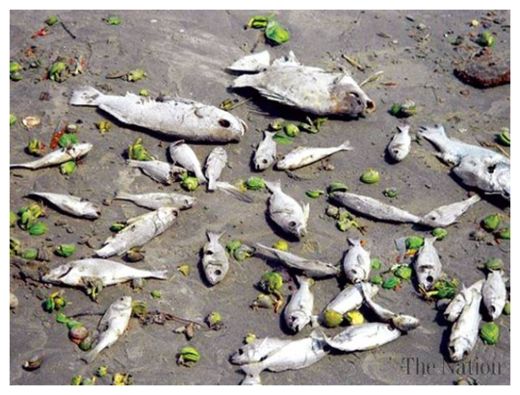
© The Nation, Pakistan
Karachi - Another case of fish mortality, mainly consisting of grey mullets surfaced within Karachi Port extending between Bab Island and Chinna Creek.
This is the second such case in the month of August 2013, in which a huge quantity fish have died. This mortality was attributed to pollution brought in by rain water flowing through Sindh Industrial Trading Estate (SITE) and laden with toxic chemicals when entered Karachi Harbour. It is estimated that about 100 m. tons fish have died.
During the present event of mortality, small quantity of fishes have died and beached in patches along Clifton beach since day before yesterday. Tiger tooth croaker, John croaker, mullets, terapons, scat, sea breams and other small fishes inhabiting open coastal waters along Clifton were observed to have been affected.
The mortality is attributed to red tide, a phenomenon which occurred due to abrupt an immense growth of small sized plant which is found in the sea. The reason for inducing sudden increase in this toxic plant (collectively known as phytoplankton) is not well understood.
Rab Nawaz, Director, WWF-Pakistan has pointed out the recurring of mortality may affect the livelihood of the fishermen of the coastal area. Mortality on account of toxic phytoplankton can be wide spread and direct or indirect consumption of such dead fishes can be harmful for human being as well. He further informed that WWF-Pakistan has collected the samples of fishes to get them analysed and identify the species of phytoplankton which was the cause of the present mortality.
Muhammad Moazaam Khan, Technical Advisor (Marine Fisheries) WWF-Pakistan informed that abrupt and immense growth of phytoplankton is known as "Harmful Algal Bloom" (HAB) or "Red tide". Phytoplankton are not harmful to human being and marine animals. However, because of a number of reasons some of which are still not well understood, these microscopic algae grow in million resulting in change in colour of the water which may range from green to blood red. Locally known as
mara paani (in Sindhi) and
bad aab (in Balochi) is a phenomenon of regular occurrence in Pakistan sometime resulting in mortality of fishes.
Khalid Mahmood, Co-Principal Investigator and Saba Ayub, Data Enumerator of WWF - Pakistan who surveyed the area pointed out that mortality of the fishes is widespread along entire Clifton coast mainly in Do Darya and Sea View but the quantities are not large. Most of the dead fishes have already been collected for fish meal processors.
Muhammad Moazzam Khan showed concern on use of dead fish on account of toxic bloom for fish meal and direct human consumption can lead to serious health issue. He further pointed out that WWF-Pakistan is working with National Institute of Oceanography to identify the species of phytoplankton responsible for mortality of fishes.

Reader Comments
to our Newsletter